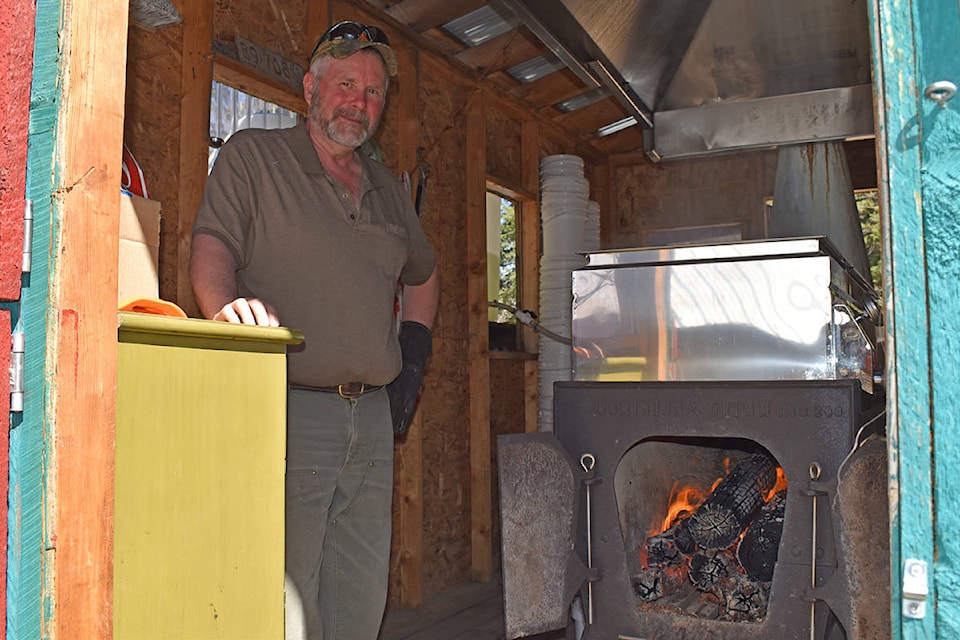Spring is a busy time of year for Ted Traer of Moose Meadows Farm. He spends up to 16 hours a day making syrup from what he describes as nature’s Gatorade from the birch trees in his backyard.
Since 2006 Traer and his wife Heloise Dixon-Warren have been producing birch syrup at their property near Bouchie Lake on Nazko Road west of Quesnel.
READ MORE: Bouchie Lake residents record history with Rural Road Name Challenge
He recalled stumbling across an article at the Houston library in the mid-1990s listing all the different sugar contents of trees.
“It said while you could make syrup out of birch you have all these other maples with a higher sugar content, so why would you bother,” Traer said.
“The short story why you bother is because not everywhere in Canada do you have maple trees.”
Traer and Dixon-Warren moved to their farm in 2002.
When Traer tapped his first birch tree he admits he wasn’t entirely sure what he was doing. Although he first tapped maple trees when he was in high school in New Brunswick back in 1977 and cooked the sap down into syrup on his mother’s stove, there are distinct differences between maple and birch.
Maple syrup is perfect for pancakes and rich in sweetness, while birch syrup, which has a lower sugar content, is excellent for cooking with and making marinades and vinaigrettes.
“Our theory when we came here was I was going to grow some Christmas trees, my wife wanted some horses, and we were going to get a couple of chickens,” Traer said.
“That was what we kind of had planned at the time.”
Before getting into the production of birch syrup, Traer and Dixon-Warren had a Christmas wreath business that kept them busy. Traer said they also didn’t want to step on anyone’s toes as another nearby farm was already producing birch syrup.
An ad seeking birch sawlogs also piqued their curiosity, although they would ultimately decide against it.
“We talked to someone in town and they said the world is the market—-there’s only a handful of producers across the country, so we said, OK, let’s give a go.”
Starting off wasn’t easy and came with its own set of challenges.
Traer said he got an old ‘ugly’ stove with doors that didn’t close properly from a buddy of his in exchange for a case of beer to serve as an evaporator.
Since they were going to put in a new deck, Traer also built a shed off the front of their home with some plywood and lumber wrap, which he said looked terrible.
“After work on this old wood stove with some restaurant pans, I made birch syrup at the end and what that told us was that it was viable,” he said, noting they tapped around 14 trees resulting in 1,000 litres of sap they were able to evaporate.
To officially get into the production of birch syrup, Traer touched base with a supplier in the maple syrup industry in Montreal, as there are no birch suppliers to order an evaporator. He also built a sugar shack which would house it.
“Sugaring” off typically occurs in early spring and lasts between two to four weeks when sap is collected and processed on a wood-fired evaporator.
Traer said the best time to collect sap is when the ground has started to thaw, and the trees are just waking up from winter. If you wait until the trees begin to bud, the natural sugar within the sap starts to change and will ferment, he said.
Every day about 600 litres of sap is collected from the 200 to 300 trees at Moose Meadows Farm and brought back via truck where it is put in a holding tank that is fed through the evaporator, which removes water and any sediment that Traer scoops off.
While some producers have gone high-tech, Traer prefers to keep things old school and hands on as he runs the wood-fire evaporator late into the night.
“It’s a bit of labour of love,” he said.
“To me it’s Canadian because every kid in eastern Canada has gone to the sugar bush for the last 40 years, and it gets you in touch with what’s out there.”
Once the concentrate reaches a specific sugar density, Traer removes it from the evaporator, which is not designed for birch, and puts it in the freezer. It is eventually slightly thawed and put upside down on a stainless steel rack which the concentrate flows out of.
In the end, a grapefruit chunk of ice results in a now-lucrative syrup that is ready to be bottled.
“Any time you can remove water from birch and not use heat you’re going to make a better flavour,” he said, noting reverse osmosis, which is an expensive and complex alternative, can also be used to remove water.
The syrup is bottled at Moose Meadows Farm, where it has been sold to chefs across Canada and the United States.
Traer said he enjoys it over a good vanilla ice cream and plank salmon with some garlic or pepper. Sometimes, when the night is cold in the sugar shack and the day has been long, Traer also enjoys it mixed with whiskey.
Dixon-Warren, who wrote a manual sold around the world on birch syrup production, said it can be used to make a lovely cheesecake, although it will set you back by using about one cup that is worth around $25.
“It’s been great in terms of diversifying our farm,” she said.
READ MORE: Pretty, Darn, Cute — Quesnel farm celebrates rare livestock birth
Do you have a comment about this story? email:
rebecca.dyok@wltribune.com
Like us on Facebook and follow us on Twitter.
